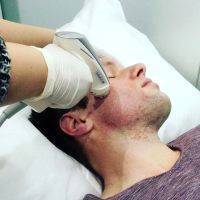What Causes Wrinkles On Face?
Wrinkles are folds, creases, or furrows that typically appear on the face, neck, tops of the forearms, and the backs of the hands.
Wrinkles are usually described as “surface lines” or “deep furrows” depending on their severity and depth. Consider this overview on the causes of wrinkles to learn more.
Age: Your skin loses elasticity as you age. In fact, studies show that after age 20, a person produces 1% less collagen with each passing year.
This causes the skin to become more fragile as it diminishes the elastin and glycosaminoglycans and reduces oil and sweat gland functioning – ultimately causing wrinkles.
Sun Exposure: Another leading cause of fine lines and wrinkles is overexposure to the sun’s ultraviolet light. Individuals with lighter skin tend to develop wrinkles faster as they experience higher levels of sun damage, while those with shorter hair styles may also develop wrinkles earlier in life due to the lack of shade. A good way to try and combat sun damage is to wear hats or long sleeved clothing in order to reduce UV exposure.
Repeated Facial Expressions: Every time you use a facial muscle, a groove forms under the skin. While younger skin will bounce back without causing a permanent line, older individuals who repeatedly frown, squint, or smile will develop wrinkles earlier than those who do not make these facial expressions.
Smoking: Smoking reduces your body’s blood supply to the skin, forcing your skin to wrinkle at an accelerated rate. Individuals who smoke may also develop wrinkles around their mouth much sooner than others due the facial movements associated with smoking.
Wrinkles may be an inevitable part of the aging process, but that doesn’t mean you have to live with them.
If you’ve ever wondered what causes wrinkles, this video has the answers you need, as well as some neat demonstrations to help you visualize what goes on in your skin.
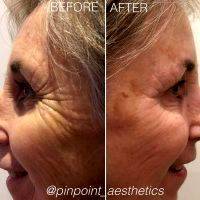
Galvanic Wrinkle Treatment Before And After
There are two causes of wrinkles: Wrinkles due to photoaging occur because too much unprotected sun exposure causes the collagen and elastin in the skin to break down. Repeated creasing of the skin also causes wrinkles – when skin is often folded or stretched, such as during frowning or smiling, eventually it won’t be able to reshape correctly, leaving fine lines and wrinkles.
Everyday Activities that You Never Knew Caused Wrinkles
Aging is a fact of life, but there are ways you can fight the signs of premature aging. While Thermage treatment can resolve many signs of aging – such as deep creases, wrinkles, and fine lines on the face – there are certain activities that you can avoid to stave off the formation of wrinkles in the first place.
Smoking: Smoke can cause premature skin aging because it can lead to dryness. Cigarette smoke and other forms of nicotine deplete the body of vitamin C, which is essential for helping the skin remain plump and moist. When the skin dries out, it becomes less flexible and pliable, leading to an increase in wrinkle formation. It’s important to note that some researchers believe cigarette smoke is just as damaging as ultraviolet rays.
Avoiding the Gym: Exercise helps increase blood circulation, and blood flow can help keep skin healthy and vibrant. Living a sedentary life slows the flow of blood, which can keep your skin from getting the nutrient-rich blood and oxygen it needs to remain healthy, pliable, and young-looking. Remaining active also helps keep your skin stay taut so that fewer wrinkles form.
Drinking Alcohol: When you drink alcohol, the small blood vessels in your skin dilate, which increases the blood flow near the skin’s surface. This makes these blood vessels at risk for damage. Once damaged, your skin develops a permanent flushed appearance and uneven skin tone. Furthermore, when the blood vessels break, they inhibit blood flow to the skin’s surface, further creating an aged appearance.
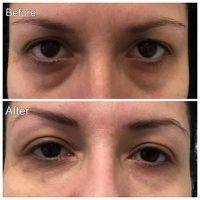
Wrinkle Treatment Around Eyes Before And After
Stress: It’s no secret that stress has devastating effects on the heart and body, but did you know that stress can cause premature aging?
When you experience stress, you use your frowning muscles to furrow your eyebrows, tighten your lips, and squint. Prolonged stress causes these facial muscles to conform to these positions, which can contribute to the development of deep creases and wrinkles.
Wrinkles signify skin aging. Although some would say that they are signs of wisdom and intelligence that people garnered over the years. Both can be true, but most folks nowadays are conscious of their looks and concerned on how to defy their age.
Wrinkles usually appear on the most sun-exposed parts of the body. These include your face, neck, backs of the hands and top parts of your forearms.
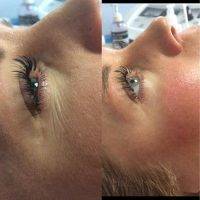
Wrinkle Treatment Before And After
There are two categories of wrinkles: fine wrinkles [fine lines] and deep wrinkles [deep furrows]. Fine lines can be treated by medicated creams, while deeper furrows require more aggressive approaches such as plastic surgery, fillers and other latest techniques.
Factors that promote/cause wrinkles
There are many factors that can cause wrinkles. These factors usually have direct impact on a person’s skin and/or his/her health.
- Heredity [if it runs in the family]
- Occupation [usually outdoor and field occupations such as farming]
- Recreational activities [sailing, golfing and other outdoor sports]
- Tanning [from tanning booths, outdoors such as the beach and resort poolside]
- If you have light skin, you are prone to wrinkles due to sun damage
- Smoking
There are many other factors such as poor diet and other unhealthy habits. Stopping these unhealthy practices and keeping your skin protected from the sun can lessen or control wrinkles.

Wrinkle Treatment Cream Photo
Wrinkle Treatments
There are two categories of wrinkle treatments: one is through medical approach and the other is through cosmetic approach.
Medical Wrinkle Treatments:
- AHA or Alpha Hydroxy Acids – these usually come as topical skin creams and moisturizers, and most dermatologists prescribe them for fine wrinkles
- Antioxidants – may contain vitamins A, C, E and beta-carotene; creams with antioxidants may also contain sun protection
- Vitamin A acids – are usually prescribed by dermatologists and they come as cream preparations; popular brands include Retin-A and Renova
Cosmetic Wrinkle Treatments:
-
- Skin peeling – for finer lines there’s Glycolic acid peels; for deeper wrinkles, trichloloacetic and salicylic acids are the ingredients of choice
- Dermabrasion – is a surgical procedure that requires general anesthesia; the skin is sanded down using a “sanding” instrument to remove the damaged top skin to expose the smoother layer from beneath
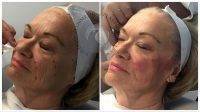
Wrinkle Treatment Injections Before And After
-
- Microdermabrasion – is also sanding the skin to expose the smoother skin underneath, but this procedure uses aluminum or silica crystals to smoothen the skin’s surface
- Laser resurfacing – is more precise than dermabrasion, but has similar results; this procedure uses erbium and CO2 lasers to stimulate the skin’s natural collagen production which then helps plump up the skin
- Other new laser treatments – such as Fractional resurfacing and non-ablative laser resurfacing are more high-tech and they offer faster healing
- Radiofrequency and heat treatments – are non-invasive wrinkle treatments that use radiofrequencies to heat the skin tissues; infrared light is used to treat the skin and results suggest that they are safe and can produce desirable results; this technique is still under development though
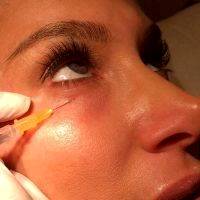
Wrinkle Treatment Injections
- Botox – is the treatment that uses minute doses of botulinum toxin-B, a paralyzing bacterium that is associated with botulism; injections of Botox on the wrinkle area helps immobilize the muscles to prevent more wrinkles to develop
- Plastic surgery – treatments such as facelift and brow lifts help remove wrinkles and smoothen the skin; these treatments are quite invasive in nature
- Fillers – such as collagen, hyaluronic acid and calcium hydroxylapatite are some of the substances that can be used; these treatments are quite popular to celebrities and the elite
Treating wrinkles should be taken seriously. Ask your dermatologist about the benefits and the type of treatment that will work for you.
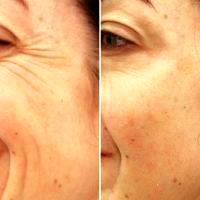
Wrinkles Mainly Happen On The Parts Of The Body That Get The Most Sun Exposure
Wrinkles are here to stay, whether we like it or not. But with many treatment options, you can delay the appearance of wrinkles and enjoy defying your age.
3 Things You Can Do to Look and Feel Younger
It’s no surprise that many individuals strive to slow the aging process – but with so many products and procedures to choose from, determining the best way to look and feel younger is not always an easy task. Check out these actions you can take, including using the revolutionary Thermage treatment, to keep yourself looking and feeling great.
Eat a Healthy Diet
Maintaining a healthy diet to keep your blood sugar levels in check and your digestive system working properly will help you feel great and boost your energy levels.
Furthermore, nutritionists state that eating a healthy diet has a direct effect on your mood. Eat foods that are rich in folic acid and vitamin B12, such as lean meats, fish, low-fat dairy, poultry, beans, and dark green vegetables. When eating fruits and vegetables, look for items that are rich in color, as these have higher levels of antioxidants. It is also important to consume foods that contain high levels of Vitamin D, calcium, and selenium, as these can all increase your energy levels and improve your mood.Exercise Regularly
Exercise is not only good for your overall health, but has also been shown to make you feel younger. In fact, one study found that individuals who participated in regular exercise had significantly longer telomeres, which are the portion of DNA strands that act as markers for the aging process. Consider low-impact exercises like yoga, walking, or swimming to look and feel years younger.
Undergo a Thermage Treatment
Treatment using Thermage CPT offers a great way to improve the look and feel of your skin. This non-invasive treatment option utilizes radiofrequency energy to heat deep layers of your skin and boost collagen production, ultimately reducing the look of fine lines, wrinkles, and sagging areas of skin so that you can look and feel more youthful.


